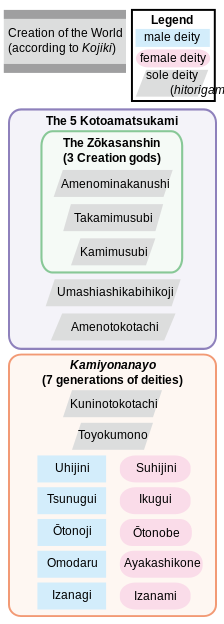Umashiashikabihikoji

Umashiashikabihikoji is a Japanese primordial deity.[1][2] He was the fourth one to come into existence.[2]
His name in Japanese is 宇摩志阿斯訶備比古遅神. He is also known as "Fine Budding Reed Lad". He is in the Kojiki and Nihongi. These are ancient Japanese texts. He is one of the earliest gods in Shinto.[2][1]
The Kojiki calls this deity Umashiashikabihikoji no kami. The Nihongi refers to it as Umashiashikabihikoji no mikoto.[1] He is one of the five Kotoamatsukami according to the Kojiki.[3] He is only cited in an "alternate writing" in the Nihon Shoki.[3]
Umashiashikabihikoji is linked to the creation of heaven and earth. The land was like floating oil at first. It moved like a jellyfish. A reed-like object appeared in this state. It turned into the kami Umashiashikabihikoji.[1]
Kamimusubi came before him, and he was succeeded by Amenotokotachi.[1]
He is a Hitorigami, or a singular divinity born early in the universe.[1]
He was not mentioned as an Oyagami or clan ancestor.[3]
In the Kojiki
[edit]The Kojiki is an old and important Japanese text. It says Umashiashikabihikoji was the fourth kami to appear. He appeared with other deities like Ametokotachi. They hid themselves after appearing. Umashiashikabihikoji has a gendered name. He is the first kami with such a name.[2]
The Kojiki says Umashiashikabihikoji was the fourth kotoamatsukami. The kotoamatsukami were deities who appeared alone. They are called hitorigami. These deities then hid themselves away.[1]
Nihongi variations
[edit]The Nihongi is another important text. It has different stories about Umashiashikabihikoji. One story says he formed from a reed shoot. This happened after Heaven and Earth separated. Another story says he was the second kami to appear. He appeared after Amenotokotachi. Amenotokotachi also formed from a reed shoot.[2]
The Nihongi gives different stories. In some, Umashiashikabihikoji is the first kami. In others, it is the second. This kami is not linked to any clans. Its role is in the early stages of the world. This shows the variety in Shinto myths. It highlights the connection between nature and the divine in Japanese beliefs.[1]
References
[edit]- ^ a b c d e f g h "Encyclopedia of Shinto - Home : Concepts of Kami : Hitorigami". 2011-05-18. Archived from the original on 2011-05-18. Retrieved 2023-03-22.
- ^ a b c d e "Umashiashikabihikoji • . A History . . of Japan . 日本歴史".
- ^ a b c "Umashiashikabihikoji | 國學院大學デジタルミュージアム". 2023-03-21. Archived from the original on 2023-03-21. Retrieved 2023-11-17.
